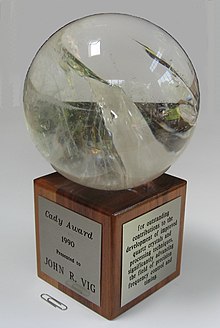John Vig: Difference between revisions
Kj cheetham (talk | contribs) Authority control |
Added category |
||
| Line 64: | Line 64: | ||
[[Category:1942 births]] |
[[Category:1942 births]] |
||
[[Category:Jewish physicists]] |
[[Category:Jewish physicists]] |
||
[[Category:Jewish Hungarian scientists]] |
|||
[[Category:Holocaust survivors]] |
[[Category:Holocaust survivors]] |
||
[[Category:Semiconductor physicists]] |
[[Category:Semiconductor physicists]] |
||
Revision as of 05:50, 24 June 2022
A major contributor to this article appears to have a close connection with its subject. (May 2022) |
John R. Vig | |
|---|---|
Vig János | |
 | |
| Born | 31 May 1942 Budapest, Hungary |
| Nationality | American |
| Education | B.S., M.S., Ph.D. |
| Alma mater | The City College of New York, B.S.; Rutgers, The State University of New Jersey, Ph.D. |
| Occupation | Physicist |
| Known for | UV-ozone cleaning, Chemical polishing of quartz surfaces, Polyimide bonding of resonators, Noise in MEMS,Tutorial on quartz resonators[2] |
| Relatives | Miklos Vig |
| Awards | 2020 IEEE Richard M. Emberson Award, 2006 C.B. Sawyer Memorial Award, 1990 IEEE UFFC Cady Award[1] |
| Scientific career | |
| Fields | Physics |
| Institutions | U.S. Army Research Lab, Fort Monmouth, New Jersey, U.S. |
| Thesis | The Kondo effect in some dilute magnetic alloys of zinc (1969) |
| Doctoral advisor | Prof. Bernard Serin |
John Vig (born 31 May 1942) is a physicist, executive and inventor. His career has been with the U.S. Army Research Lab and he has also been active with the IEEE and is known for his inventions in UV-ozone cleaning, chemical polishing of quartz surfaces, polyimide bonding of resonators and noise in MEMS.[3]

Early life and education
Born in Budapest to a Jewish family during World War II, he survived The Holocaust and left Hungary with his immediate family during the Hungarian Revolution in 1956. He settled in New York City with his family in 1957 and subsequently received a B.S. degree from City College New York in 1964. In 1969 he received a Ph.D. in Physics from Rutgers University. After graduating he began his professional career at the Electronic Components Laboratory at Fort Monmouth.[4]
Career
He has served the IEEE in multiple roles, including:
- IEEE President and CEO.[5]
- President of the Ultrasonics, Ferroelectrics, and Frequency Control Society (UFFC-S)[6]
- Founding President of the Sensors Council[7]
- Division Director, Member of the Board of Directors[8]
He was elected Fellow of the IEEE in 1988 "for contributions to the technology of quartz crystals for precision frequency control and timing."[9]
While in senior management roles in the IEEE, John focused heavily on key issues affecting the organization as demographics, technologies and globalization shifted the environment in which it operated. A key example was the management of diversity as the membership shifted away from being primarily a US-based organization.[10] Another example was helping to kick-start the Internet of Things journal after having founded the Sensors Journal.[11]
References
- ^ "Walter G. Cady Award | IEEE UFFC". ieee-uffc.org. Retrieved 2022-05-23.
- ^ "John R Vig". scholar.google.com. Retrieved 2022-05-23.
- ^ "Quartz crystal resonators and oscillators for frequency control and timing applications. A tutorial". scholar.google.com. Retrieved 2022-05-24.
- ^ "Oral-History:John Vig". ETHW. 2021-01-26. Retrieved 2022-05-21.
- ^ "List of Presidents of the Institute of Electrical and Electronics Engineers (IEEE)". ETHW. 2021-01-21. Retrieved 2022-05-21.
- ^ "IEEE Ultrasonics, Ferroelectrics, and Frequency Control Society History". ETHW. 2021-03-03. Retrieved 2022-05-21.
- ^ "IEEE Sensors Council History". ETHW. 2022-01-12. Retrieved 2022-05-21.
- ^ "IEEE Board of Directors". ETHW. 2022-02-22. Retrieved 2022-05-23.
- ^ "IEEE Fellow Grade History". ETHW. 2020-03-03. Retrieved 2022-05-21.
- ^ "Q&A About IEEE Diversity". IEEE Spectrum. 2010-10-06. Retrieved 2022-05-25.
- ^ "First-Hand:The IEEE Internet of Things Journal Started With a Conversation About Bread". ETHW. 2021-09-09. Retrieved 2022-05-25.
